Oh sweet, sweet Georgia! The land of southern hospitality, vast orchards of delicious peaches, and forty-seven species of snakes! Believe it or not, Georgia has the highest number of snake species of any U.S. state. Thankfully, only six species are venomous, and only four of them are deadly. But with that many kinds of snakes, you must know how to identify the deadly! The top four largest and most dangerous snakes in Georgia are the copperhead, eastern/southern diamondback rattlesnake, cottonmouth, and timber rattlesnake. But which one is the largest, most deadly venomous snake? We will count them down for you, starting with an honorable mention to a snake that isn’t deadly, but still deserves respect!
The Top Four Largest (And Most Dangerous) Snakes In Georgia
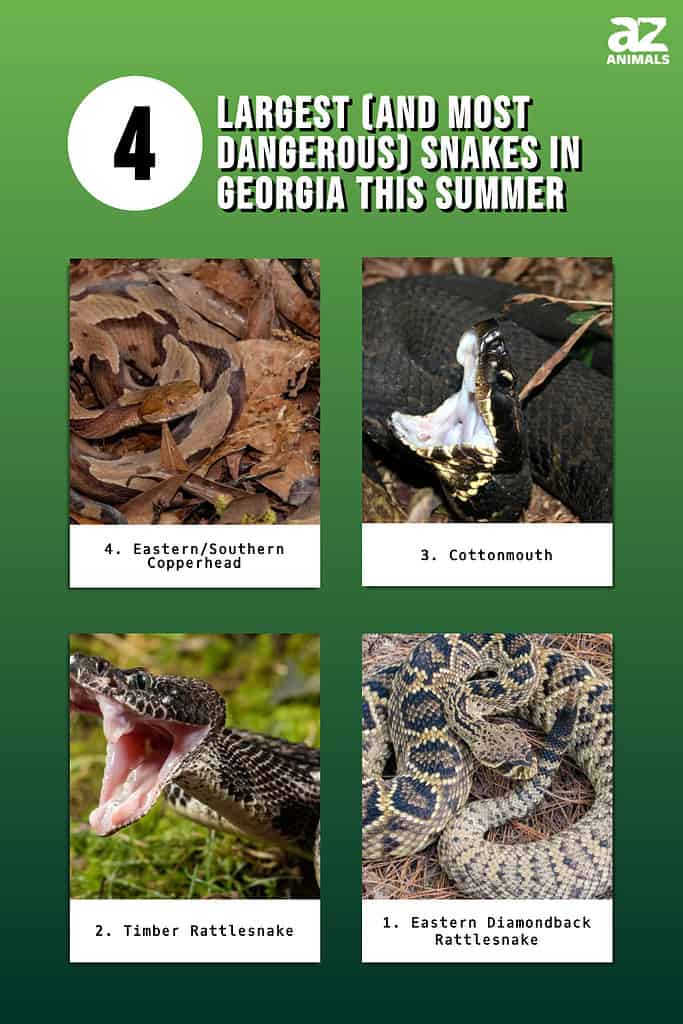
There are quite a few snakes that call Georgia home, but only six species are venomous. Of those, there are four species that are large enough and dangerous enough to kill. In this section, we count down the top four largest and most dangerous. Also, we’ll start things off with an honorable mention to a species that is neither large nor deadly, but a formidable snake just the same!
Honorable Mention: The Pygmy Rattlesnake Is Small But Dangerous!
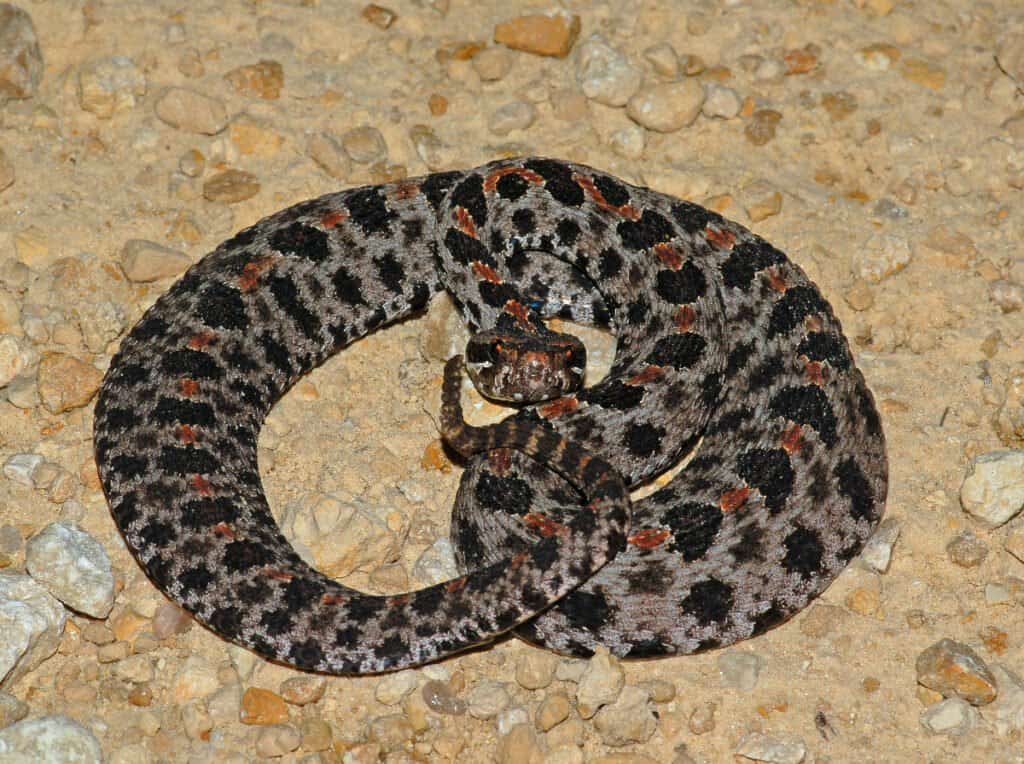
The pygmy rattlesnake is the fifth largest snake in Georgia, and while its venom isn’t deadly, it can cost you a finger or limb!
©Gerald A. DeBoer/Shutterstock.com
| Size | 12-24 inches long |
| Venom | Rarely deadly, but can result in lost fingers or limbs without medical care |
| Habitat | Urban or suburban locations, landscaping, brush |
| Behavior | Moderately aggressive, often attacks with little warning, and rarely rattles |
Of Georgia’s three rattlesnake species, the pygmy rattlesnake is the smallest and least dangerous. The species is only found in the southeastern United States and is one of the few pit vipers that live near humans. This species lacks the heavy neurotoxins or ability to produce the amount of venom that makes larger rattlers deadly. However, the cocktail of other toxins it produces can cause serious medical issues, even the loss of a finger or limb!
This species can be identified by its elongated body and broad head. The pygmy rattlesnake is grey overall with darker blotching and small reddish-brown dots.
4. Eastern/Southern Copperhead
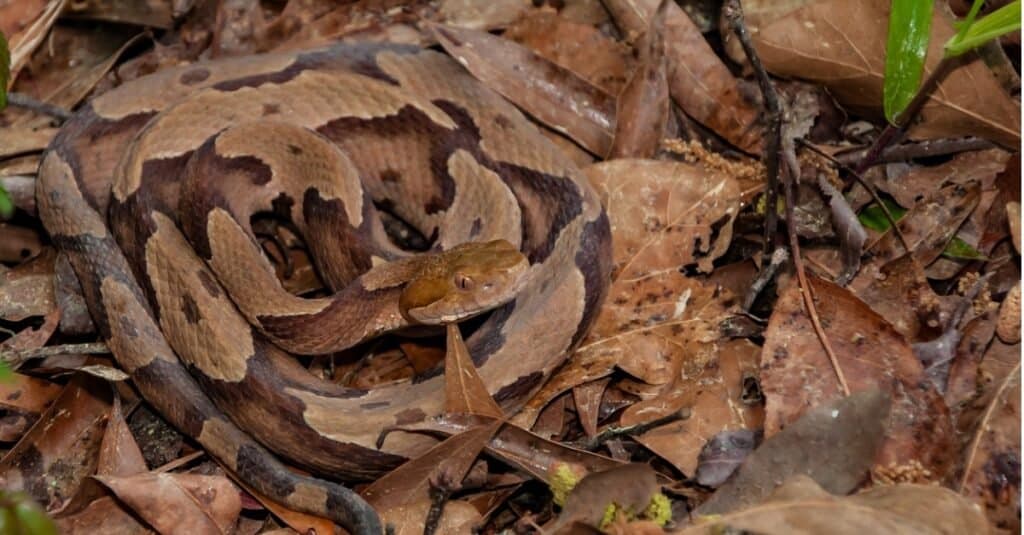
The Eastern/Southern species of Copperhead is the fourth largest species of snake in Georgia. While their bite isn’t always deadly, it is extremely painful and can kill without medical attention.
©iStock.com/JasonOndreicka
| Size | 24-36 inches long |
| Habitat | Rocky or high elevations and marshlands |
| Venom | Extremely painful but not deadly, risk of infection |
| Behavior | Extremely aggressive, strikes with no warning, blends well with surroundings |
The copperhead is named for its overall reddish-brown coloring and can be identified by the brown hourglass markings over the body. Copperheads are pit vipers, with characteristic triangular heads and slitted, catlike pupils. This species is nocturnal but is significantly more active in the fall and spring. Due to its unique color and pattern, the copperhead is a master of camouflaging itself.
3. Cottonmouth (Water Moccasin)
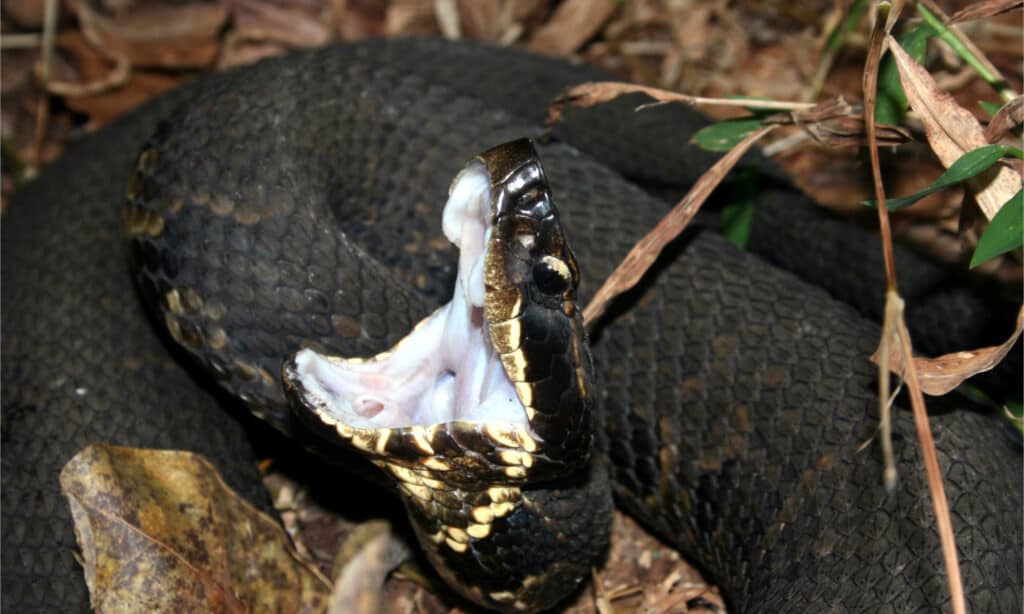
Cottonmouths are the third-largest venomous snake in Georgia, and its bite is the cause of roughly 1 percent of snakebite fatalities in the United States. However, the species is not particularly aggressive and bites occur mostly by accidental contact.
©Psychotic Nature/Shutterstock.com
| Size | 20-48 inches long |
| Habitat | Swamps, marshlands, any location with standing water |
| Venom | Deadly without medical attention |
| Behavior | Moderately aggressive, raises and tilts head back and opens mouth wide to reveal white “cotton colored” interior as a warning. |
Like many locations where standing water is common, the cottonmouth is a common venomous snake in Georgia, mostly in the southeast portion of the state. While not particularly aggressive, the cottonmouth generally attacks due to being stepped on or disturbed in water. Because of their remarkable ability to blend into their environment, they account for around one percent of deadly snake bites in the United States.
The cottonmouth is reddish-brown with black banding when young but may darken to grey or black with age. They can be most easily identified by their signature open mouth warning, which reveals the stark, cotton-colored white interior.
2. Timber Rattlesnake
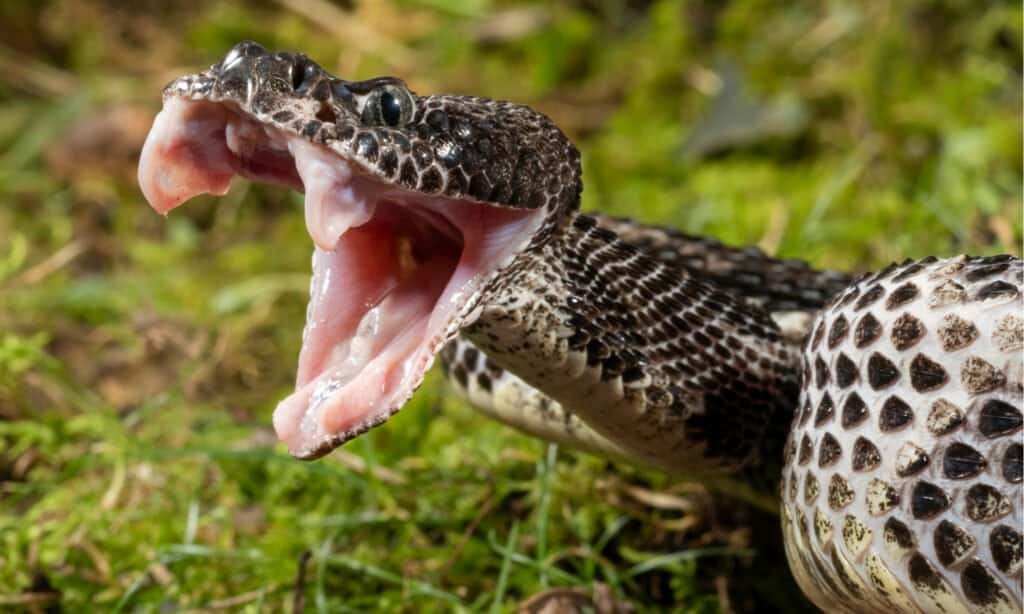
Timber Rattlesnakes are the second largest and most deadly venomous snake in Georgia. They have the most deadly and concentrated venom of any state in the U.S.
©Joe McDonald/Shutterstock.com
| Size | 36-60 inches long |
| Habitat | Forests, farms, agricultural areas, lowlands |
| Venom | Most concentrated venom of any U.S. snake, deadly without prompt medical attention |
| Behavior | A mildly aggressive ambush hunter with a little warning prior to striking, running is advised |
The timber rattlesnake is found throughout the state of Georgia and is without question the most dangerous. Thankfully, like most rattlesnakes it is an ambush predator, so the timber species is not outwardly aggressive. While this snake has the most powerful and deadly venom of all United States snakes, bites are rare. However, when a bite occurs, it can kill an adult human in minutes.
Timber rattlesnakes can be identified by their yellow-grey bodies, brown/black arrow markings, and the reddish-brown stripe down the back. Timber rattlesnakes may also have darker brown banding over the entire body.
1. Eastern Diamondback Rattlesnake

Eastern diamondback rattlesnakes are the largest deadly snake in Georgia and the entire United States. The largest diamondback was 8 feet long!
©Chase D’animulls/Shutterstock.com
| Size | 36-72 inches long |
| Habitat | Dry areas, scrub, bushes, woodpiles, and occasionally near water |
| Venom | Deadly without prompt medical attention |
| Behavior | Mildly aggressive, lifts head slowly in warning along with rattle, strikes very quickly from up to 4 feet |
The largest (and most dangerous) snake in Georgia is the eastern diamondback rattlesnake which is the largest venomous snake in the United States. The largest rattlesnake ever was an eight-foot-long diamondback! While this snake has an impressive striking distance and incredible speed, it is slow to attack. Often, the diamondback will remain quite still and wait for you to leave.
The diamondback is brown over the entire body, with a distinctive brown diamond pattern outlined in yellow. They can also be identified by the black markings striping the face, as well as the narrow shape and slitted eyes common in pit vipers. If these black face markings are missing, or the snout is upturned and pointed, the snake in question is the diamondback’s lookalike, the eastern hognose!
Up Next
- Is It Illegal To Kill Snakes In Georgia?
- 10 Of The Most Common (And Non Venomous )Snakes In Georgia
- 10 Black Snakes In Georgia
The photo featured at the top of this post is © iStock.com/Wide-River-Rick
Discover the "Monster" Snake 5X Bigger than an Anaconda
Every day A-Z Animals sends out some of the most incredible facts in the world from our free newsletter. Want to discover the 10 most beautiful snakes in the world, a "snake island" where you're never more than 3 feet from danger, or a "monster" snake 5X larger than an anaconda? Then sign up right now and you'll start receiving our daily newsletter absolutely free.
Thank you for reading! Have some feedback for us? Contact the AZ Animals editorial team.







